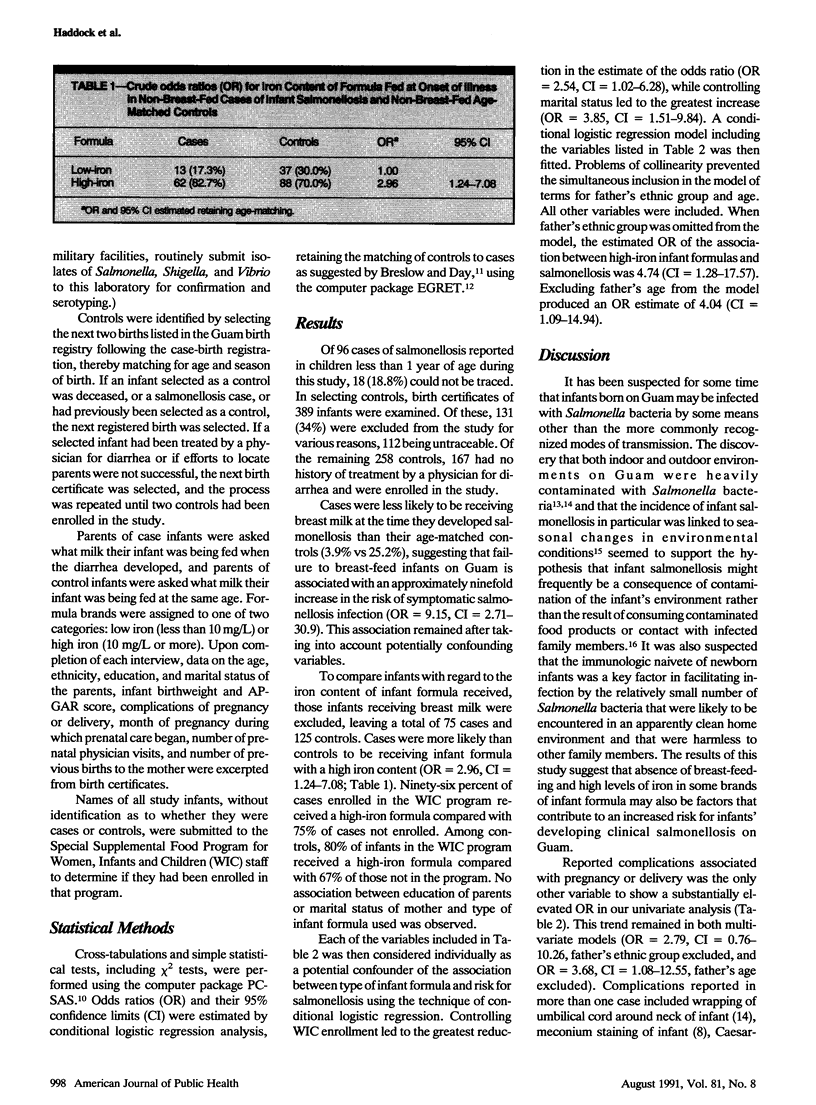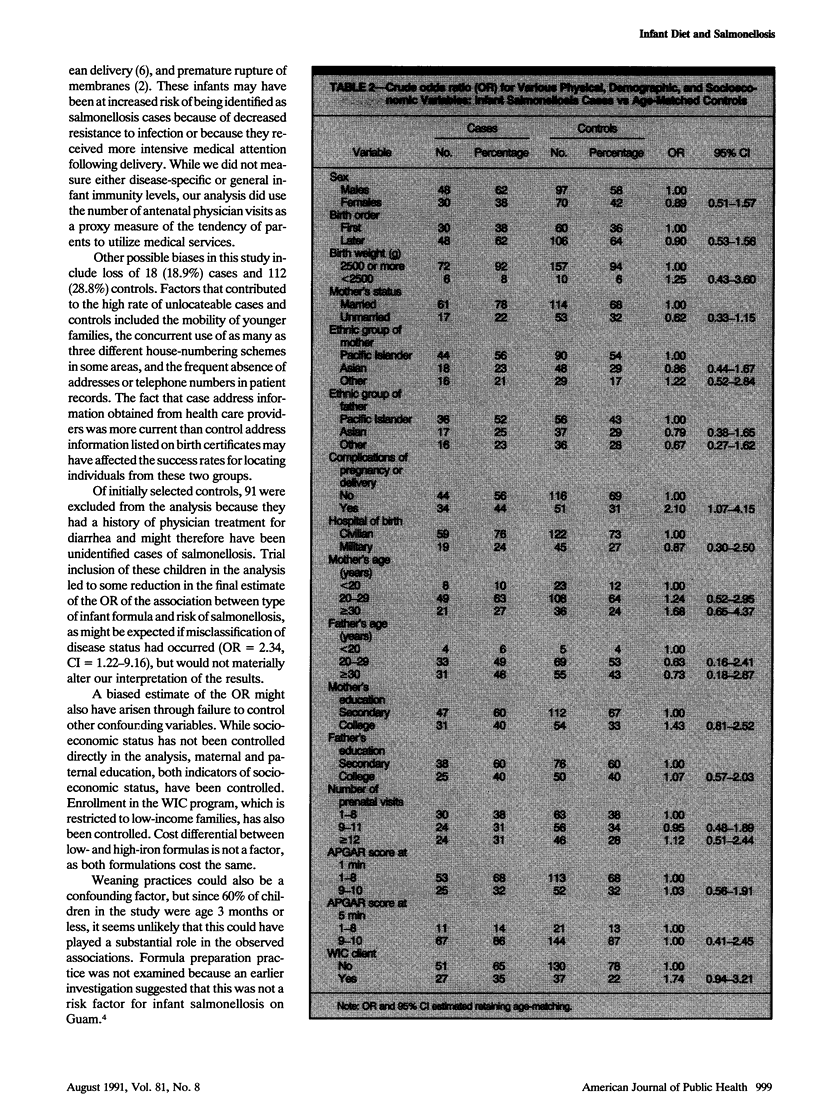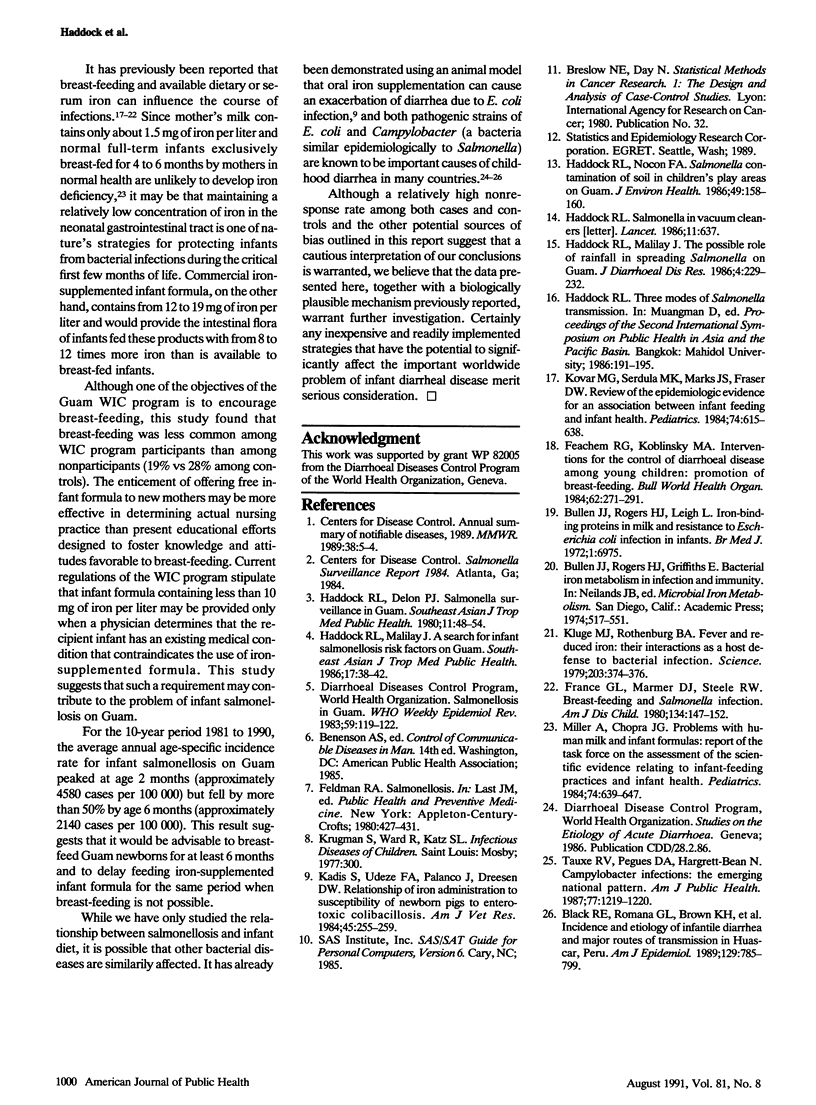Abstract
BACKGROUND: The Island of Guam has experienced a high incidence of infant salmonellosis for a number of years (age-specific incidence rate of approximately 3700 cases per 100,000 infants in 1984). Interviews of case parents suggested that the use of high-iron infant formula was associated with this problem. METHODS: A case-control study was conducted to test this hypothesis. Information on feeding practices and a variety of medical and socioeconomic factors was collected for 78 laboratory-confirmed Salmonella-case infants and 167 control infants. RESULTS: Case infants were less likely to have been breast-fed (odds ratio [OR] = 9.15; 95% confidence interval [CI] = 2.71-30.9) and more likely to have been fed infant formula with an iron content of 10 mg/L or greater (OR = 2.96; 95% CI = 1.24-7.08) than were control infants. CONCLUSIONS: Although the precise means by which infants are most commonly exposed to Salmonella bacteria remain obscure, breast-feeding apparently protects against the development of physician-diagnosed clinical salmonellosis, while the feeding of high-iron infant formula has the opposite effect.
Full text
PDF



Selected References
These references are in PubMed. This may not be the complete list of references from this article.
- Black R. E., Lopez de Romaña G., Brown K. H., Bravo N., Bazalar O. G., Kanashiro H. C. Incidence and etiology of infantile diarrhea and major routes of transmission in Huascar, Peru. Am J Epidemiol. 1989 Apr;129(4):785–799. doi: 10.1093/oxfordjournals.aje.a115193. [DOI] [PubMed] [Google Scholar]
- Feachem R. G., Koblinsky M. A. Interventions for the control of diarrhoeal diseases among young children: promotion of breast-feeding. Bull World Health Organ. 1984;62(2):271–291. [PMC free article] [PubMed] [Google Scholar]
- France G. L., Marmer D. J., Steele R. W. Breast-feeding and Salmonella infection. Am J Dis Child. 1980 Feb;134(2):147–152. doi: 10.1001/archpedi.1980.02130140021007. [DOI] [PubMed] [Google Scholar]
- Haddock R. L., Delon P. J. Salmonella surveillance in Guam. Southeast Asian J Trop Med Public Health. 1980 Mar;11(1):48–54. [PubMed] [Google Scholar]
- Haddock R. L., Malilay J. A search for infant salmonellosis risk factors on Guam. Southeast Asian J Trop Med Public Health. 1986 Mar;17(1):38–42. [PubMed] [Google Scholar]
- Haddock R. L., Malilay J. The possible role of rainfall in spreading Salmonella on Guam. J Diarrhoeal Dis Res. 1986 Dec;4(4):229–232. [PubMed] [Google Scholar]
- Haddock R. L. Salmonella in vacuum cleaners. Lancet. 1986 Sep 13;2(8507):637–637. doi: 10.1016/s0140-6736(86)92467-0. [DOI] [PubMed] [Google Scholar]
- Kadis S., Udeze F. A., Polanco J., Dreesen D. W. Relationship of iron administration to susceptibility of newborn pigs to enterotoxic colibacillosis. Am J Vet Res. 1984 Feb;45(2):255–259. [PubMed] [Google Scholar]
- Kluger M. J., Rothenburg B. A. Fever and reduced iron: their interaction as a host defense response to bacterial infection. Science. 1979 Jan 26;203(4378):374–376. doi: 10.1126/science.760197. [DOI] [PubMed] [Google Scholar]
- Kovar M. G., Serdula M. K., Marks J. S., Fraser D. W. Review of the epidemiologic evidence for an association between infant feeding and infant health. Pediatrics. 1984 Oct;74(4 Pt 2):615–638. [PubMed] [Google Scholar]
- Tauxe R. V., Pegues D. A., Hargrett-Bean N. Campylobacter infections: the emerging national pattern. Am J Public Health. 1987 Sep;77(9):1219–1221. doi: 10.2105/ajph.77.9.1219. [DOI] [PMC free article] [PubMed] [Google Scholar]


